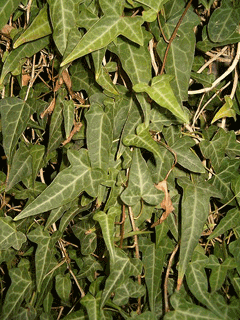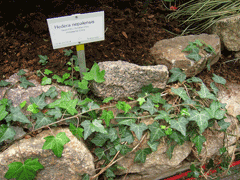 |
|
http://commons.wikimedia.org/wiki/User:BotBln |
 |
|
Translate this page:
Summary
Physical Characteristics

 Hedera nepalensis is an evergreen Climber growing to 15 m (49ft) by 5 m (16ft) at a medium rate.
Hedera nepalensis is an evergreen Climber growing to 15 m (49ft) by 5 m (16ft) at a medium rate.
See above for USDA hardiness. It is hardy to UK zone 8. It is in leaf all year. The species is hermaphrodite (has both male and female organs) and is pollinated by Bees, flies, Lepidoptera (Moths & Butterflies).
It is noted for attracting wildlife.
Suitable for: light (sandy), medium (loamy) and heavy (clay) soils and can grow in heavy clay and nutritionally poor soils. Suitable pH: mildly acid, neutral and basic (mildly alkaline) soils and can grow in very alkaline soils.
It can grow in full shade (deep woodland) semi-shade (light woodland) or no shade. It prefers moist or wet soil and can tolerate drought. It can tolerate atmospheric pollution.
UK Hardiness Map
US Hardiness Map
Synonyms
Plant Habitats
Woodland Garden Dappled Shade; Shady Edge; not Deep Shade; Bog Garden; North Wall. By.
Edible Uses
References More on Edible Uses
Medicinal Uses
Plants For A Future can not take any responsibility for any adverse effects from the use of plants. Always seek advice from a professional before using a plant medicinally.
Cathartic Diaphoretic Skin Stimulant
The leaves and the berries are said to be cathartic, diaphoretic and stimulant[243]. A decoction of the plant is used to treat skin diseases[272].
References More on Medicinal Uses
The Bookshop: Edible Plant Books
Our Latest books on Perennial Plants For Food Forests and Permaculture Gardens in paperback or digital formats.

Edible Tropical Plants
Food Forest Plants for Hotter Conditions: 250+ Plants For Tropical Food Forests & Permaculture Gardens.
More

Edible Temperate Plants
Plants for Your Food Forest: 500 Plants for Temperate Food Forests & Permaculture Gardens.
More

More Books
PFAF have eight books available in paperback and digital formats. Browse the shop for more information.
Shop Now
Other Uses
References More on Other Uses
Cultivation details
Ivy is a very easily grown plant that dislikes waterlogged, very dry or very acid soils but otherwise succeeds in all soil types[1, 17, 238]. It grows well in heavy clay soils. Prefers some lime in the soil. Tolerates very dense shade[24, 31], though it may not flower in such a position[K]. This species is not hardy in all parts of Britain, tolerating temperatures down to about -5 to -10°c[200]. Ivy is a rampant climbing plant, clinging by means of aerial roots and often trailing on the ground in woods and hedges[186]. It is of benefit rather than harm when growing on a wall because it keeps the wall dry and acts as an insulation[11, 24]. It does not damage the structure of a wall. Similarly, it does not harm large trees when climbing into them, though it can shade out smaller and ailing trees[200]. It is not a parasitic plant, but instead obtains all its nutrient from the sun and the soil[186]. This species is notably resistant to honey fungus[200].
References Carbon Farming Information and Carbon Sequestration Information
Temperature Converter
Type a value in the Celsius field to convert the value to Fahrenheit:
Fahrenheit:
The PFAF Bookshop
Plants For A Future have a number of books available in paperback and digital form. Book titles include Edible Plants, Edible Perennials, Edible Trees,Edible Shrubs, Woodland Gardening, and Temperate Food Forest Plants. Our new book is Food Forest Plants For Hotter Conditions (Tropical and Sub-Tropical).
Shop Now
Plant Propagation
Seed - remove the flesh, which inhibits germination, and sow the seed in spring in a cold frame[113]. Four weeks cold stratification will improve germination[113]. When they are large enough to handle, prick the seedlings out into individual pots and grow them on in the cold frame for their first winter. Plant them out into their permanent positions in late spring or early summer, after the last expected frosts. Cuttings of half-ripe wood, July/August in a shady position in a frame. Good percentage[78]. Cuttings of mature wood, 12cm long, November in a cold frame[78]. Layering. Plants often do this naturally.
Other Names
If available other names are mentioned here
Native Range
TEMPERATE ASIA: Afghanistan, China (Anhui Sheng, Fujian Sheng, Gansu Sheng (south), Guangdong Sheng, Guangxi Zhuangzu Zizhiqu, Guizhou Sheng, Henan Sheng, Hubei Sheng, Hunan Sheng, Jiangsu Sheng, Jiangxi Sheng, Shaanxi Sheng (south), Shandong Sheng, Sichuan Sheng, Xizang Zizhiqu (south), Yunnan Sheng, Zhejiang Sheng) TROPICAL ASIA: Bhutan, India (north), Nepal, Laos, Myanmar, Thailand, Vietnam
Weed Potential
Right plant wrong place. We are currently updating this section.
Please note that a plant may be invasive in one area but may not in your area so it's worth checking.
Conservation Status
IUCN Red List of Threatened Plants Status :

Growth: S = slow M = medium F = fast. Soil: L = light (sandy) M = medium H = heavy (clay). pH: A = acid N = neutral B = basic (alkaline). Shade: F = full shade S = semi-shade N = no shade. Moisture: D = dry M = Moist We = wet Wa = water.
Now available:
Food Forest Plants for Mediterranean Conditions
350+ Perennial Plants For Mediterranean and Drier Food Forests and Permaculture Gardens.
[Paperback and eBook]
This is the third in Plants For A Future's series of plant guides for food forests tailored to
specific climate zones. Following volumes on temperate and tropical ecosystems, this book focuses
on species suited to Mediterranean conditions—regions with hot, dry summers and cool, wet winters,
often facing the added challenge of climate change.
Read More
Expert comment
Author
K.Koch.
Botanical References
200
Links / References
For a list of references used on this page please go here
Readers comment
| Add a comment |
|
If you have important information about this plant that may help other users please add a comment or link below. Only comments or links that are felt to be directly relevant to a plant will be included. If you think a comment/link or information contained on this page is inaccurate or misleading we would welcome your feedback at [email protected]. If you have questions about a plant please use the Forum on this website as we do not have the resources to answer questions ourselves.
* Please note: the comments by website users are not necessarily those held by PFAF and may give misleading or inaccurate information.
To leave a comment please Register or login here All comments need to be approved so will not appear immediately.
|
Subject : Hedera nepalensis
|
|
|
|